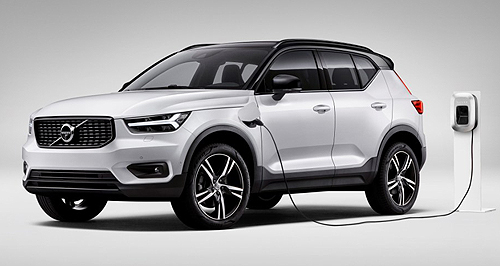Make / Model Search
Future models - Volvo - XC40New XC40 to kickstart Volvo’s full-electric futureHigh 5: The XC40 T5 Twin Engine plug-in hybrid made its global debut at the recent Beijing motor show and is expected to arrive late next year or early in 2020 alongside Volvo’s first all-electric variant. Volvo confirms Aussie rollout of electrified XC40s and role in global EV strategyGallery Click to see larger images 7 May 2018 By TERRY MARTIN THE fully electric version of Volvo’s new XC40 small SUV due late next year or early in 2020 will be the Swedish brand’s first foray into zero-emissions motoring in Australia, bolstering a burgeoning range of electrified vehicles that will include all-electric and plug-in hybrid variants in every model line.
The XC40 range launched last week will expand in late 2019 with the car-maker’s first three-cylinder engine – an economical 115kW/265Nm 1.5-litre turbo-petrol T3 unit that will also be combined with an electric motor to produce the T5 Twin Engine plug-in hybrid variant that is expected to launch alongside the full-electric version around the same time.
Volvo Car Australia’s new managing director Nick Connor confirmed the model rollout to GoAuto – noting that the launch of the electrified versions could push into early 2020 – and reaffirmed its commitment to the global strategy that will see all new models released from 2019 available as either a mild hybrid, plug-in hybrid or battery-electric vehicle.
Mr Connor said Volvo Car Australia had an obligation and responsibility to offer electrified vehicles wherever possible, despite the segment only accounting for a fraction of total new-vehicle sales.
He did emphasise, however, that the Australian subsidiary’s ability to achieve Volvo Cars’ just-announced new target of 50 per cent of global sales coming from fully electric cars by 2025 would depend on broader issues such as consumer attitudes and the rollout of recharging infrastructure.
“We have to be mindful of what consumers actually want,” he said. “We can make these bold statements, but ultimately consumers get to decide, and that’s the way it should be.
“Honestly, I think it’s a bold ambition, I think that in some markets it’s almost certainly achievable, and you can see what happens in markets like Norway where there’s big incentives for electric cars, the take-up is phenomenal.
“I don’t think it’s impossible, but what percentage we do in a particular market is going to be determined by the infrastructure, it’s going to be determined by tax incentives, those things are out of Volvo’s control.
“Ultimately, we’ll follow the market, we’ll have the electrified product offers here if consumers want it, but with the best will in the world, we’re not going to drive people into electrified cars if there isn’t an appropriate infrastructure or incentive for them.
“We’re committed to hybrids and fully electric cars (in Australia). My personal view is that if we’ve got a full plug-in electric vehicle, we should offer it, even if the numbers initially are quite small.
“We’re going into a new part of the market and I think we should lead. We have a responsibility to lead if we’ve got the products available. What volume we ultimately do by 2025 is not entirely up to us but I think we should put the offer out there, we’ll promote it, and promote its benefits.
“It’s not going to suit everybody and we have to accept that, but those it does suit I think we’ve got an obligation to try and persuade them.”  Read more2nd of May 2018  Driven: All-new XC40 adds ‘wow factor’ to Volvo line-upVolvo shuns downsizing design trend for all-new XC40 small SUV now on sale26th of March 2018  Volvo undercuts competition with first XC40 small SUVPremium small SUVs put on notice as Volvo XC40 goes after price leadership20th of February 2018  Volvo XC40 to get three-pot engineTurbo three-cylinder to join Aus Volvo XC40 range in 2019, PHEV and EV to followAll future models Alfa Romeo Alfa Romeo Abarth Abarth Alpine Alpine Alpina Alpina Audi Audi Aston Martin Aston Martin BMW BMW Bentley Bentley Chery Chery Brabham Brabham Chrysler Chrysler Chevrolet Chevrolet Cupra Cupra Citroen Citroen DS DS Dodge Dodge Fiat Fiat Ferrari Ferrari Foton Foton Ford Ford Great Wall Great Wall FPV FPV Haval Haval GWM GWM Honda Honda Holden Holden Hummer Hummer HSV HSV Infiniti Infiniti Hyundai Hyundai Jaguar Jaguar Isuzu Isuzu Kia Kia Jeep Jeep Land Rover Land Rover Lamborghini Lamborghini Lexus Lexus LDV LDV Mahindra Mahindra Lotus Lotus Mazda Mazda Maserati Maserati Mercedes-AMG Mercedes-AMG McLaren McLaren MG MG Mercedes-Benz Mercedes-Benz Mitsubishi Mitsubishi Mini Mini Opel Opel Nissan Nissan Peugeot Peugeot Pagani Pagani Proton Proton Porsche Porsche Renault Renault Ram Ram Rover Rover Rolls-Royce Rolls-Royce Skoda Skoda Saab Saab SsangYong SsangYong Smart Smart Suzuki Suzuki Subaru Subaru Toyota Toyota Tesla Tesla Volvo VolvoXC40 pricing
Motor industry news |
Click to shareVolvo modelsResearch Volvo All future models Alfa Romeo Alfa Romeo Abarth Abarth Alpine Alpine Alpina Alpina Audi Audi Aston Martin Aston Martin BMW BMW Bentley Bentley Chery Chery Brabham Brabham Chrysler Chrysler Chevrolet Chevrolet Cupra Cupra Citroen Citroen DS DS Dodge Dodge Fiat Fiat Ferrari Ferrari Foton Foton Ford Ford Great Wall Great Wall FPV FPV Haval Haval GWM GWM Honda Honda Holden Holden Hummer Hummer HSV HSV Infiniti Infiniti Hyundai Hyundai Jaguar Jaguar Isuzu Isuzu Kia Kia Jeep Jeep Land Rover Land Rover Lamborghini Lamborghini Lexus Lexus LDV LDV Mahindra Mahindra Lotus Lotus Mazda Mazda Maserati Maserati Mercedes-AMG Mercedes-AMG McLaren McLaren MG MG Mercedes-Benz Mercedes-Benz Mitsubishi Mitsubishi Mini Mini Opel Opel Nissan Nissan Peugeot Peugeot Pagani Pagani Proton Proton Porsche Porsche Renault Renault Ram Ram Rover Rover Rolls-Royce Rolls-Royce Skoda Skoda Saab Saab SsangYong SsangYong Smart Smart Suzuki Suzuki Subaru Subaru Toyota Toyota Tesla Tesla Volvo VolvoXC40 pricing
Motor industry news |

















Facebook Twitter Instagram